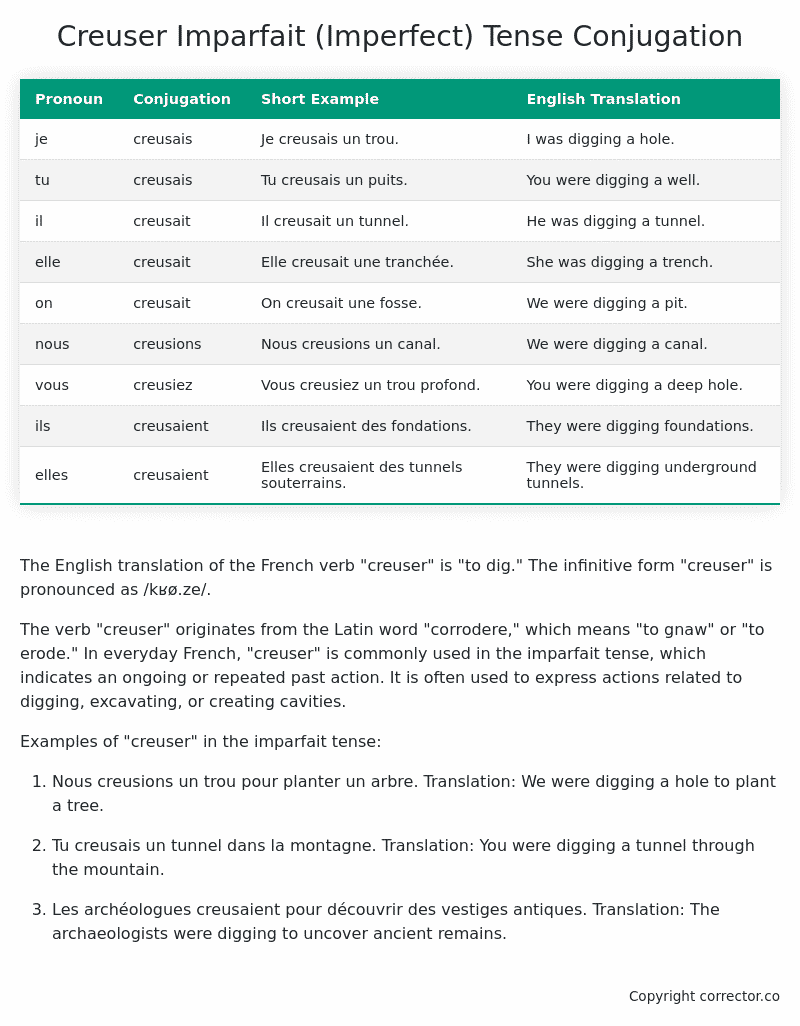Imparfait (Imperfect) Tense Conjugation of the French Verb creuser
Introduction to the verb creuser
The English translation of the French verb “creuser” is “to dig.” The infinitive form “creuser” is pronounced as /kʁø.ze/.
The verb “creuser” originates from the Latin word “corrodere,” which means “to gnaw” or “to erode.” In everyday French, “creuser” is commonly used in the imparfait tense, which indicates an ongoing or repeated past action. It is often used to express actions related to digging, excavating, or creating cavities.
Examples of “creuser” in the imparfait tense:
-
Nous creusions un trou pour planter un arbre.
Translation: We were digging a hole to plant a tree. -
Tu creusais un tunnel dans la montagne.
Translation: You were digging a tunnel through the mountain. -
Les archéologues creusaient pour découvrir des vestiges antiques.
Translation: The archaeologists were digging to uncover ancient remains.
Table of the Imparfait (Imperfect) Tense Conjugation of creuser
| Pronoun | Conjugation | Short Example | English Translation |
|---|---|---|---|
| je | creusais | Je creusais un trou. | I was digging a hole. |
| tu | creusais | Tu creusais un puits. | You were digging a well. |
| il | creusait | Il creusait un tunnel. | He was digging a tunnel. |
| elle | creusait | Elle creusait une tranchée. | She was digging a trench. |
| on | creusait | On creusait une fosse. | We were digging a pit. |
| nous | creusions | Nous creusions un canal. | We were digging a canal. |
| vous | creusiez | Vous creusiez un trou profond. | You were digging a deep hole. |
| ils | creusaient | Ils creusaient des fondations. | They were digging foundations. |
| elles | creusaient | Elles creusaient des tunnels souterrains. | They were digging underground tunnels. |
Other Conjugations for Creuser.
Le Present (Present Tense) Conjugation of the French Verb creuser
Imparfait (Imperfect) Tense Conjugation of the French Verb creuser (You’re reading it right now!)
Passé Simple (Simple Past) Tense Conjugation of the French Verb creuser
Passé Composé (Present Perfect) Tense Conjugation of the French Verb creuser
Futur Simple (Simple Future) Tense Conjugation of the French Verb creuser
Futur Proche (Near Future) Tense Conjugation of the French Verb creuser
Plus-que-parfait (Pluperfect) Tense Conjugation of the French Verb creuser
Passé Antérieur (Past Anterior) Tense Conjugation of the French Verb creuser
Futur Antérieur (Future Anterior) Tense Conjugation of the French Verb creuser
Subjonctif Présent (Subjunctive Present) Tense Conjugation of the French Verb creuser
Subjonctif Passé (Subjunctive Past) Tense Conjugation of the French Verb creuser
Subjonctif Imparfait (Subjunctive Imperfect) Tense Conjugation of the French Verb creuser
Subjonctif Plus-que-parfait (Subjunctive Pluperfect) Tense Conjugation of the French Verb creuser
Conditionnel Présent (Conditional Present) Tense Conjugation of the French Verb creuser
Conditionnel Passé (Conditional Past) Tense Conjugation of the French Verb creuser
Conditionnel Passé II (Conditional Past II) Tense Conjugation of the French Verb creuser
L’impératif Présent (Imperative Present) Tense Conjugation of the French Verb creuser
L’impératif Passé (Imperative Past) Tense Conjugation of the French Verb creuser
L’infinitif Présent (Infinitive Present) Tense Conjugation of the French Verb creuser
L’infinitif Passé (Infinitive Past) Tense Conjugation of the French Verb creuser
Le Participe Présent (Present Participle) Tense Conjugation of the French Verb creuser
Le Participe Passé (Past Participle) Tense Conjugation of the French Verb creuser
Struggling with French verbs or the language in general? Why not use our free French Grammar Checker – no registration required!
Get a FREE Download Study Sheet of this Conjugation 🔥
Simply right click the image below, click “save image” and get your free reference for the creuser imparfait tense conjugation!

Creuser – About the French Imparfait Tense
NOTE: To take a deep dive into all the French tenses then see our article on Mastering French Tense Conjugation.
Formation of the Imparfait Tense
For regular -er verbs:
For regular -ir verbs
For regular -re verbs
Common Everyday Usage Patterns
Description of Past Habits
Background Information
Mental and Emotional States
It’s employed to express emotions, thoughts, or physical sensations in the past. For example: “J’étais content quand il est arrivé.” (I was happy when he arrived.)
Ongoing Actions
Points to Note About the Imparfait Tense
Passé Composé vs. Imparfait
Conditional
Si Clauses
Narration
I hope you enjoyed this article on the verb creuser. Still in a learning mood? Check out another TOTALLY random French verb imparfait conjugation!


